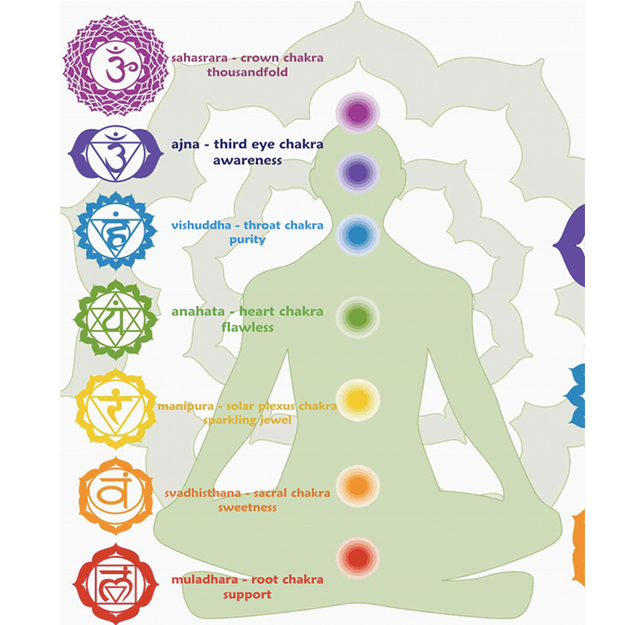Svadhishthana Chakra (Sacral Chakra)
Yoga is for Posers.

Svadhisthana chakra is shown as having six petals, bearing the Sanskrit letters ba, bha, ma, ya, ra, and la. The seed sound in the centre is vam. The tattwa for the element of Water is shown as a silver crescent. Svadhishthana (Sanskrit: ???????????, IAST: Sv?dhi??h?na, English: "where your being is established." "Swa" means self and "adhishthana" means established.) or the sacral chakra, is the second primary chakra according to Hindu Tantrism. This chakra is blocked by fear especially the fear of death. Svadhisthana is illustrated as a white lotus (Nelumbo nucifera). It has six vermilion-colored petals inscribed with syllables: ?? ba?, ?? bha?, ?? ma?, ?? ya?, ?? ra? and ?? la?. Inside this lotus is a white crescent moon which represents the water region presided over by the deity Varuna. The seed mantra, located in the innermost circle, is a moon-white ?? va?. Above the mantra that is within the bindu, or dot, is the deity Vishnu. He is dark blue and wears a yellow dhoti. He holds a conch, a mace, a wheel and a lotus. He wears the shrivatsa mark, and the kaustubha gem. He is seated either on a pink lotus, or on the divine eagle Garuda. His strength is the goddess Rakini. She is black, dressed in red or white and seated on a red lotus. She is commonly depicted with one face and two arms, holding a sword and a shield, or two faced and four armed, and holds a trident, lotus, drum and vajra, or an arrow, skull, drum and axe. Some schools teach that the divinities of the Sv?dhishth?na Chakra are Brahm? and Sarasvat?. Brahm? is the creator of the Universe and Saraswati personifies knowledge. The six petals represent the following modes of consciousness, also known as vrittis: affection, pitilessness, feeling of all-destructiveness, delusion, disdain and suspicion. Svadhisthana is associated with the unconscious and with emotion. It is closely related to the Muladhara in that Muladhara is where the different samskaras (potential Karmas) lie dormant, and Svadhisthana is where these Samskaras find expression. It is associated with the element of water, the sense of taste and the act of procreation. Svadhisthana contains unconscious desires, especially sexual desire. It is said, that to raise the kundalini shakti (energy of consciousness) above Svadhisthana is difficult. Many saints have had to face sexual temptations associated with this chakra. One who meditates on Svadhisthana is believed to obtain the following siddhis: freedom from enemies, the status of a lord among yogis, eloquence and clarity ("words flowing like nectar in well-reasoned discourse"), loss of fear of water, awareness of astral entities and the ability to taste anything desired for oneself or others. Svadhisthana is located two finger-widths above the Muladhara chakra (Sanskrit: ???????, IAST: M?l?dh?ra, English: "root support") or root chakra which is located in the coccyx (tailbone). Its corresponding point in the front of the body (i.e. its kshetram) is barely below the belly button. It is connected with the sense of taste, (the tongue) and with reproduction (the genitals). It is often associated with the testes and ovaries. They produce the hormones testosterone or estrogen, which influence sexual behaviors. They are stored in areas where genetic information lies dormant, in the same way that samskaras lie dormant within Svadhisthana. Svadhisthana chakra with the ocean of samskara, the moon of bindu chakra, the sky from anahata and the stars. Practices in kundalini yoga to control and balance the energy in Svadhisthana chakra include vajroli mudra (contraction of the genitals), ashvini mudra (contraction of the anus), and various asanas and pranayamas. The equivalent chakra in the Vajrayana tantra systems of Tibet is called the "Secret Place" four fingers below the navel. It is red in colour, with 32 downward pointing spokes. Meditation on this point produces great bliss. According to certain interpretations of Sufism, the spiritual body of a man is defined as an interconnected system (Lataif-e-sitta), in which there is an energy center called the nafs. According to Lataif-e-sitta, the nafs is just below the navel. The nafs incorporates all the elements of man's 'lower self,' which is tamed in order to attain closeness to Allah. Western occultists make the kabbalistic association of Svadhisthana with the Sephirah Yesod. Yesod is also associated with the sexual organs. Its function in the tree of life is to gather the different energies that have been created in the descent of the tree downwards and distribute them to Malkuth, the material world, where the energy can find physical expression. Svadhishthana Chakra (Sacral Chakra)
Representation
Characteristics
Association with the body
Practices
Comparisons
Alternative names